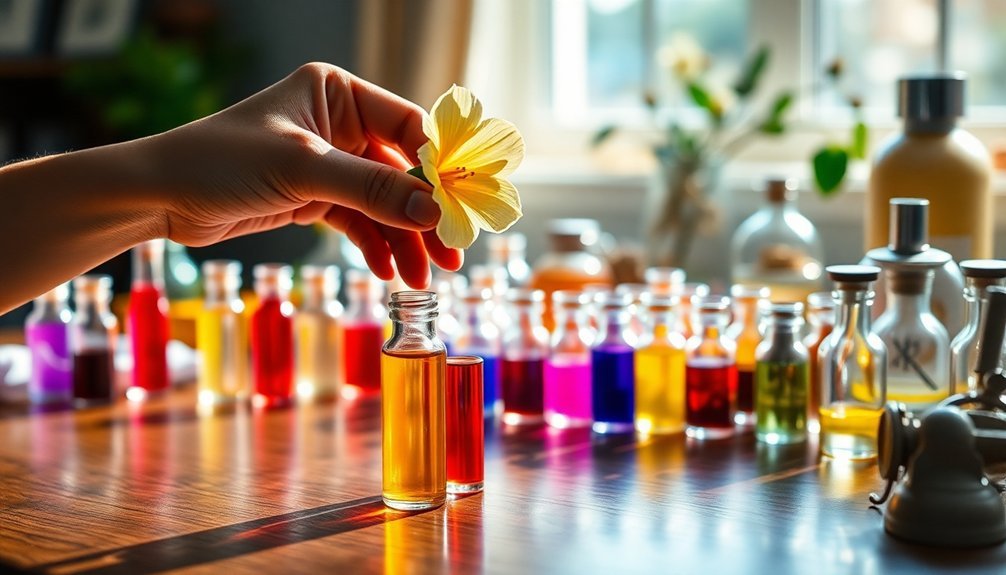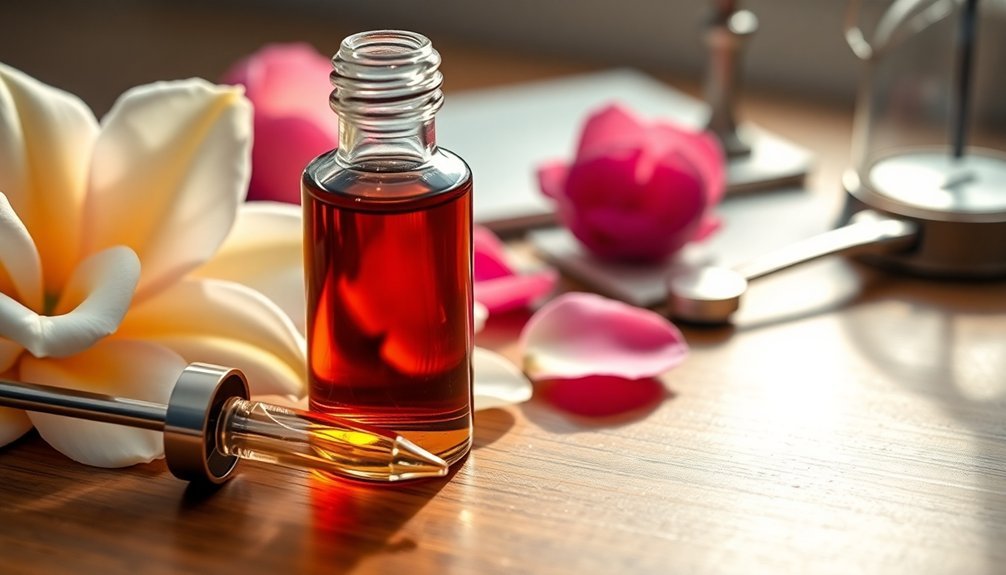When layering heart notes in perfumes, you'll want to start with one dominant floral or spicy note as your foundation, like jasmine or cardamom. Add complementary notes drop by drop, carefully recording each addition. Let your blend mature for at least a week, testing on paper strips and skin to evaluate the progression. Use precise measuring tools and maintain a 3:2:1 ratio of top:heart:base notes. The secrets of professional perfumers lie in understanding these essential mixing techniques.
Understanding the Role of Heart Notes in Fragrance Design

While perfume creation is often considered an art, understanding heart notes is essential to mastering fragrance design. These middle notes form the fragrance's core, emerging after the top notes fade within the first hour of application. They make up about 70% of your perfume's total scent profile.
You'll find heart notes introduce depth through floral, spicy, and woody elements. Classic ingredients like jasmine, rose, cinnamon, and cardamom create complex emotional responses while bridging the gap between fleeting top notes and lasting base notes. The aromatic heart notes remain prominent throughout the fragrance's life, providing consistency to the overall scent experience.
As they interact with your skin, they evolve to create a unique olfactory experience. In the fragrance pyramid, heart notes serve as the central anchor, ensuring smooth progressions between initial impressions and final base notes. Their stability weaves together distinct scent layers, creating a harmonious symphony.
Selecting Compatible Heart Notes for Your Blend
Three key factors guide the selection of compatible heart notes: their intensity, longevity, and harmony with other fragrance components.
You'll want to start with full-bodied florals like jasmine or ylang-ylang as your foundation, then layer in complementary notes that add dimension to your blend. A proper blend requires 15 to 20 minutes to fully develop its heart notes after application.
Consider incorporating spicy elements like cardamom or cinnamon to create warmth, or fresh notes like lemongrass to brighten the composition.
- Combine rose or lavender absolute with orange blossom to achieve a soft, powdery character
- Add tuberose or frangipani for creamy, rich undertones
- Mix black pepper with neroli to create an intriguing sweet-spicy contrast
- Balance woody notes like pine with floral elements to guarantee proper depth
Remember to test your combinations over time, as heart notes will interact differently with both top and base notes.
Essential Tools and Materials for Heart Note Mixing

You'll need precise measuring tools like droppers and graduated cylinders to create accurate heart note blends that can be consistently reproduced.
Your storage vessels, including refillable bottles and airtight containers, must be clean and properly labeled to maintain the integrity of your fragrance mixtures.
These tools, combined with proper documentation of measurements and formulas, will guarantee your perfume creations mature properly and remain stable over time.
Starting with paper test strips helps you evaluate potential combinations before committing to final blends.
Precision Mixing Equipment
Successful perfume mixing relies on having the right precision equipment at your fingertips.
You'll need high-quality stainless steel measuring tools to guarantee your heart notes blend perfectly. From graduated cylinders for exact measurements to precise droppers and pipettes for oil transfer, each tool plays a vital role in creating your signature scent.
Don't forget to keep a thermometer handy to monitor temperature during the mixing process.
- Stainless steel measuring cups and spoons for consistent portions
- Graduated cylinders for accurate liquid measurements
- Droppers and disposable pipettes for precise oil transfer
- Thermometers to maintain ideal mixing temperatures
These precision tools will help you maintain consistency in your perfume formulations and make certain that each batch meets your exacting standards.
Storage and Maturation Vessels
Once you've measured and mixed your perfume components with precision tools, proper storage becomes the next key consideration.
You'll need dark glass bottles that protect your fragrance from light degradation, storing them in their original boxes for extra protection.
Choose vessels that are specifically designed for alcohol-based perfumes, as these benefit most from the maturation process.
You'll want to store your containers in a cool, dry place – avoid bathrooms or areas with direct sunlight. The back of a drawer or closed cabinet works perfectly.
After filling your vessels, spray 5-10 pumps into the air to initiate maceration, then seal the bottle tightly.
Your perfume will need 2-4 weeks of maturation time, allowing the fragrance oils to blend seamlessly with the alcohol base and develop their full aromatic potential.
Step-by-Step Heart Note Blending Process
Creating exquisite heart notes begins with a methodical blending process that forms the foundation of your perfume.
You'll need to start by selecting your core ingredients, typically focusing on classic elements like lavender, rose, or spice. Once you've chosen your ingredients, you'll blend them drop by drop, carefully recording each addition to maintain consistency in your formula.
- Start with separate bottles for each heart note category, then combine them gradually.
- Let your blend sit for at least a week to allow the scents to properly mature.
- Evaluate your mixture after the initial aging period and make necessary adjustments.
- Continue aging your perfume for several weeks, monitoring how the heart notes interact with your skin chemistry.
Remember to shake your blend thoroughly and remain patient throughout the aging process, as this guarantees your heart notes develop their intended character.
Balancing Heart Notes With Top and Base Notes

When you're mixing perfumes, start with proven ratios like 3:2:1 (top:heart:base) to establish a solid foundation for your blend.
You'll know you've achieved note harmony when your fragrance shifts smoothly from crisp top notes through mellow heart notes and into rich base notes without any jarring shifts.
Let your blend mature for at least a few days, testing it periodically to guarantee the notes have properly melded and evolved into a cohesive scent.
Proportion Rules For Success
Three fundamental rules govern the art of balancing fragrance notes in perfume mixing.
You'll want to follow standard ratios like 1:1:1, 3:2:1, or 4:2:1 (top:middle:base) to achieve a harmonious blend.
When layering your fragrances, start with the strongest base notes, then add middle notes, and finish with the lightest top notes.
Remember to let each layer settle before applying the next one.
- Test each combination on separate paper strips before applying to your skin
- Apply scents to pulse points for ideal diffusion and longevity
- Start with small amounts and adjust proportions based on how they develop
- Match fragrance intensities to prevent one note from overwhelming others
For best results, maintain consistent quality across your chosen fragrances and consider seasonal factors when determining your final proportions.
Identifying Note Harmony
The art of harmonizing heart notes demands a delicate balance between your top and base notes to create a seamless fragrance journey.
You'll want to pair your bright, fleeting top notes with complementary heart notes – for instance, citrus top notes blend beautifully with floral heart notes.
As you develop your fragrance, make sure your heart notes don't overpower the base notes. Instead, they should act as a bridge, gracefully shifting from the initial impression to the deeper foundation notes like sandalwood or vanilla.
Consider using fewer top notes than heart notes for the best balance.
Think of your fragrance as a musical composition where each note plays its part.
Let the blend mature to achieve a refined, cohesive scent where floral, spicy, or fruity heart notes seamlessly connect all elements.
Testing Blend Maturity
Successfully testing your blend's maturity requires patience and systematic evaluation over time. You'll want to let your creation rest for several days or weeks, allowing the ingredients to meld naturally.
During this period, use blending strips to evaluate the fragrance without skin contact, which helps you assess the true scent development. Keep detailed records of each drop you've added, as this documentation proves invaluable when refining your formula.
- Test the blend on multiple surfaces to understand its behavior across different materials
- Allow at least an hour of observation time to witness the complete note progression
- Document changes in scent intensity and character throughout the maturation period
- Apply small amounts to various pulse points to gauge the fragrance's evolution and longevity
Testing and Adjusting Your Heart Note Blend

Crafting a perfect heart note blend requires systematic testing and careful adjustment throughout the development process.
Begin by applying drops of each heart note oil on labeled fragrance strips and wave them under your nose to assess their compatibility. Let your blend mature for several days, allowing the scents to mingle and settle.
To maintain objectivity during testing, use coffee beans between scent evaluations to clear your nasal receptors. Record your observations on perfume formula cards, including the blend's name, date, and fragrance description.
Aim for heart notes to comprise about 30% of your total blend, balancing them with top notes (20%) and base notes (50%). Choose complementary heart notes like floral oils and spices that effectively bridge the gap between top and base notes while creating a harmonious composition.
Perfecting Your Signature Heart Note Combination
Developing your signature heart note combination begins with understanding how different scent families interact and complement each other. When creating your unique blend, you'll want to pair complementary notes that enhance rather than overpower one another. For example, try combining a floral note like jasmine with a warm spice like cardamom, or blend rose with sandalwood for a sophisticated balance.
- Choose one dominant heart note as your foundation, then add subtle supporting notes.
- Test different ratios of your chosen notes to find the perfect balance.
- Consider your body chemistry, as heart notes can develop differently on your skin.
- Experiment with seasonal variations by adjusting the intensity of spicy or floral notes.
Remember to give your blend time to develop on your skin, as heart notes can take up to an hour to fully emerge.
Frequently Asked Questions
Can Heart Notes From Different Fragrance Families Be Mixed Successfully?
Yes, you can mix heart notes from different fragrance families successfully. You'll want to choose complementary scents, avoid overpowering combinations, and test them first to guarantee they create a harmonious blend together.
How Long Should Heart Notes Be Allowed to Settle Before Evaluation?
You'll want to wait at least 30 minutes to 2 hours before evaluating heart notes. They need time to fully develop and settle on your skin for an accurate assessment of their character.
Do Seasonal Changes Affect How Heart Notes Perform in Blends?
Yes, you'll notice your heart notes perform differently across seasons. They're stronger in summer heat and more subdued in winter cold, so you'll need to adjust your blend ratios accordingly for ideal results.
Can Synthetic and Natural Heart Notes Be Combined Effectively?
Yes, you can effectively combine synthetic and natural heart notes. They'll complement each other by bringing authenticity from naturals and consistency from synthetics, creating complex, stable fragrances with enhanced depth and longevity.
What Percentage of Heart Notes Is Ideal for a Balanced Fragrance?
For a well-balanced fragrance, you'll want heart notes to make up around 70% of your perfume composition. This proportion allows you to maintain ideal scent progression while ensuring proper longevity and sillage.
In Summary
You've now mastered the art of layering heart notes – the soul of your signature fragrance. Don't be afraid to experiment with different combinations and ratios until you find that perfect blend. Remember to test your creations thoroughly and trust your nose. With practice and patience, you'll create beautiful, harmonious fragrances that showcase your unique creative vision in perfumery.
References
- https://us.upcirclebeauty.com/blogs/upcircle/how-to-layer-fragrances
- http://pellwall-perfumes.blogspot.com/2012/06/method-for-blending.html
- https://lisstudymaterials.wordpress.com/wp-content/uploads/2017/12/dlis002_knowledge_organization_classification_and_cataloguing_theory.pdf
- https://the7virtues.com/blogs/a-blog-by-the-7-virtues/everything-you-need-to-know-to-master-the-art-of-perfume-layering
- https://woopdiy.com/blogs/news/essential-oil-perfume-recipes-guide
- https://www.fragrancex.com/blog/fragrance-notes/
- https://www.pairfum.com/heart-notes-in-perfume-the-soulful-core-of-a-fragrance/
- https://saifperfumes.com/blog/a-guide-to-perfume-notes/
- https://us.clivechristian.com/blogs/perfume-facts/what-are-the-top-heart-and-base-notes-in-a-perfume
- https://www.trendhunter.com/trends/heart-notes-collection





Leave a Reply